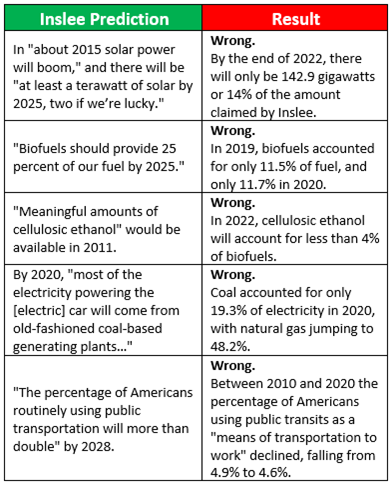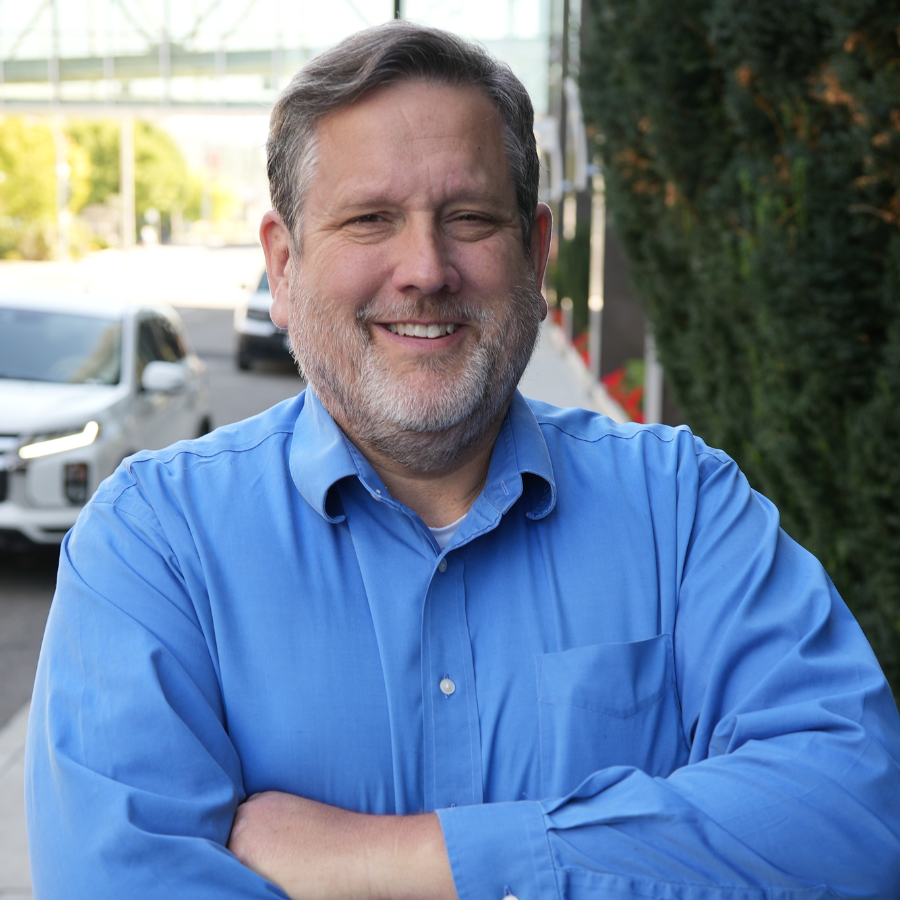Earth Day is a day to demand results not celebrate more political rhetoric.
So before the next round of environmental speeches and promises, and to prepare you with needed context for tomorrow's news, we offer the following two "must-reads" before the presidential visit.
The first, "Using the "climate crisis" to reward political allies: $5 for politics, $1 for renewable energy" exposes the inherent preference to reward political allies over environmental achievement within the Biden Administration's Build Back Better plan and the Inslee Administration's approval of that approach. The second is a blog WPC's Todd Myers posted today, "Apollo’s Misfire: Governor Inslee’s miserable record of predicting the future of climate and energy" which is explained in the title.
And finally, to highlight areas outside politics where actual environmental achievement is taking place, we encourage you to check out the announcement from yesterday about Todd Myers' upcoming book which details how new technologies and individual action are providing revolutionary solutions to serious environmental challenges worldwide.
Be sure to spread these publications far and wide, so Washington has the information it deserves on Earth Day.
#1. Using the "climate crisis" to reward political allies: $5 for politics, $1 for renewable energy
By Todd Myers
Never let a climate crisis go to waste. That is the approach politicians and special interests take when it comes to using policies purportedly designed to fight climate change to reward political allies.
Last year, as Congress was finalizing the “Build Back Better” budget proposal, they included a long list of tax credits to promote renewable energy. For example, the Production Tax Credit (PTC), rewards the generation of certain types of renewable energy for every kilowatt-hour (kWh) of electricity. The proposal offered a credit of 0.5 cents per kWh, and a “bonus” credit of 2.5 cents per kWh. To receive that bonus, generators must “pay prevailing wages during the construction phase and during the first 10 years of operation and if registered apprenticeship requirements are met.”
The proposed bonus for following union rules and using union labor was five times as large as the incentive to generate renewable energy.
With so much rhetoric about the “climate crisis,” how did Governor Inslee’s Senior Climate Advisor, Anna Lising, respond to the disparity between incentives for renewables and special interest rewards? With glee.
“Yassss labor provisions!!” she said in a September 12, 2021 email, looping in the governor's senior labor policy advisor. She went on to note that there was “a significant tax incentive for projects with strong labor provisions” (italics hers).

Instead of spending resources on maximizing the generation of renewable energy or reducing CO2 emissions, the proposal was to siphon off funding at the rate of five dollars for political allies for every one dollar to fight the “climate crisis.”
Clinton advisor Paul Begala once said, “The budget is a profoundly moral document.” Quoting the Bible, he said, “For where your treasure is, there will your heart be.” For Governor Inslee’s senior climate advisor and the authors of the Build Back Better budget, their heart is with political allies far more than it is with fighting climate change.
2. Apollo’s Misfire: Governor Inslee’s miserable record of predicting the future of climate and energy
By Todd Myers
Fourteen years after the publication of Governor Inslee’s book, his record at predicting the direction of climate policy and innovation is extremely poor
A defining characteristic of politics-based climate efforts is the belief that elected politicians and government agency staff can accurately predict the future and create laws based on their own wisdom and foresight. The evidence of this assumption occurs throughout Washington state’s climate law. Enacted law says Washington state must cut emissions in half by 2030 and to 5 percent of 1990 levels by 2050. Washington state leaders have voted to ban the sales of gas-powered vehicles by 2030. They say the state’s electricity generation must be at net-zero emissions by 2030.
The politicians who set these targets promise the goals are based in science, even though the dates they set are all conveniently divisible by five. It seems fortunate that the “science” happened to work out that way. Not surprisingly, these same politicians are routinely wrong.
Despite this miserable record, they glibly adopt new regulations and subsidies, insisting that this time they are right, and we should trust their prescience to address what they call an “existential crisis.”
Few have been more vocal and confident in their clairvoyance than Governor Jay Inslee. In 2008, then-congressman Jay Inslee staked his reputation as an expert in climate policy on a series of predictions he made at the end of the book he co-authored with Bracken Hendricks.
“Having read a book on the search for clean energy,” they wrote, “the reader is entitled to require the authors to place their bets on which technologies we believe will succeed and which will fail.” With great bravado, they promised to accept this responsibility. They wrote:
“It would be easy to walk away from this responsibility and let the future determine its own course. It would be comforting to avoid the prospect of being proven wrong by the passage of time. But your authors are built of sterner stock. We refuse to take refuge in the privilege of punditry to cloak our comments in vague surmises. We are compelled by a sense of responsibility to provide a vision of where we think the energy world really will be in ten years and beyond.”
Fourteen years later, how have Inslee and Hendricks’ predictions held up? Not well.
Despite promising not to hide behind “vague surmises,” they made several predictions without a clear timeline. There are plenty of phrases like, “Wave energy will be the sleeper technology of the next two decades,” and “the efficiency of cars will skyrocket” without clear definitions or timelines. Other predictions are for 2030, which is still too far away to assess.
But the governor made several claims with clear timelines that can be assessed today.
For example, the governor and his co-author predicted that in “about 2015 solar power will boom.” They cite a prediction from 2007 claiming the U.S. will see “at least a terawatt of solar by 2025, two if we’re lucky...” They predicted “net-metering” legislation that was proposed by Inslee would contribute to this boom.
Today we are nowhere near one terawatt of capacity, let alone two. According to the Solar Energy Industries Association, the total solar installed capacity was 121.4 gigawatts (GW) in 2021. (A terawatt is 1,000 gigawatts.) The Energy Information Administration anticipates an addition of 21.5 gigawatts in 2022, for a total of 142.9 GW. This is just over 14 percent of the projected terawatt of power. In 2020, solar energy accounted for just over two percent of electricity generation in the United States. Theoretically, there are still three years until the end of 2025, but the chances of increasing solar capacity seven-fold in three years is basically zero.
As for the role of net-metering in promoting solar, it accounts for only about 20 percent of that total.
Inslee and his coauthor noted, “Predicting solar success ‘just around the corner’ has lost many a wager over the last three decades.” Add their names to those who lost wagers betting on solar.

They also wrote, “the smart grid will replace the nineteenth-century technology of the existing electrical grid, enabling real-time pricing to rapidly increase energy-efficiency programs,” and allow more distributed generation. They claimed this would happen “rapidly.”
I wish they had been right. Real-time pricing, where customers pay rates that change as market prices increase and decrease during the day, has the potential of providing incentives to save electricity and shift demand away from the most expensive hours. The governor is, again, badly wrong.
In 2020, fewer than 10 million people were enrolled in dynamic pricing programs with about one million of those using “real-time pricing.” Utility reports show an energy savings of only 1.2 million megawatt-hours (MWh), or 0.08% of total energy used in the United States. None of those are in Washington state.
The major reason for the paltry number of people using dynamic pricing is government regulation that tightly restricts residential prices. Less regulation, not more, would create opportunities to take advantage of new technology and price incentives.
On transportation fuels, the governor had several big predictions.
First, he claimed that “biofuels should provide 25 percent of our fuel by 2025.” Again, this is very unlikely to be accurate.
In 2019, prior to COVID, U.S. drivers used about 3.4 billion barrels of gasoline. American drivers used 346.5 million barrels of ethanol and 43.2 million barrels of biodiesel. That amounts to 11.5 percent of total fuels, far short of Inslee’s prediction. In 2020, total fuel consumption fell due to COVID, but the ratio of biofuels remained much the same, about 11.7 percent. There is no chance biofuels will make up 25 percent of transportation fuels in 2025.
The incorrect prediction was based in part on another claim, which stated that in 2011, “meaningful amounts of cellulosic ethanol” would become available and that it would make a “rapid penetration of the market.” The belief was that cellulosic ethanol, a type of biofuel that was expected to cost less and emit less CO2, would become technically feasible and more available. This turned out to be totally inaccurate.
A decade after the governor’s deadline, cellulosic ethanol is virtually nonexistent. For 2021, the EPA biofuel requirement set the goal for cellulosic ethanol for just over three percent of total renewable fuel. For 2022, the target is just under four percent. More than a decade after they were to become available, there is still virtually no cellulosic ethanol.
Additionally, Governor Inslee badly missed the biggest energy transformation that occurred since he published his book: the natural gas boom. He claimed, “In the first decade, most of the electricity powering the [electric] car will come from old-fashioned coal-based generating plants…” Contrary to that prediction, the percentage of U.S. electricity supplied by coal fell from 48.2 percent in 2008 to 19.3 percent in 2020. In fact, coal provided a smaller percentage of United States electric generation than natural gas, nuclear, and combined renewables (which includes hydropower). This shift away from coal has been the leading cause of reduced CO2 emissions in the United States. In a book full of environmental predictions, the governor completely missed the most significant one of all.
Finally, the governor claimed that “the percentage of Americans routinely using public transportation will more than double in the next two decades.” Since the book was published in 2008, the deadline for this claim would be 2028, so there is still time. This prediction will fall far short. Use of public transportation was lower in 2020 than it was when Inslee made the prediction, and after COVID, ridership on public transport may never recover to pre-COVID levels, let alone double.
Between 2010 and 2020, the percentage of Americans using public transit as a “means of transportation to work” fell from 4.9 percent to 4.6 percent.
It may be said that judging this target after COVID is unfair because nobody could have expected a pandemic. Indeed, that is the point. Making predictions two decades in the future is foolhardy precisely because one cannot predict recessions, pandemics, oil shocks due to war, the pace of technological innovation, or other events that have a major impact on economics and our ability to address environmental challenges.
Despite those obvious challenges and the atrocious record of the governor and other politicians, they continue to bet the economy and environment on their ability to see into the future. They will continue to fail, and the price is ultimately paid by Washington residents, forests, salmon, wildlife, and the rest of the environment that continues to be harmed as politicians waste money believing in their own infallibility.
Rather than putting faith in the terrible record of politicians, addressing challenging environmental problems requires efforts that promote and embrace the dynamism of market-based innovation, tapping the informed and innovative decisions people make every day to help the environment.





